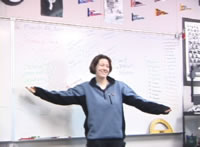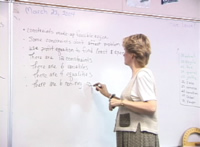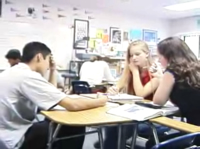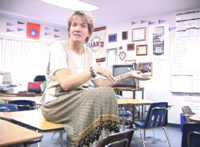Context
Where do I teach?
Content
What are my students learning?
Teaching Practice
What's my approach?
Reflections
Resources
Standards
Archive
|
CLASSROOM CULTURE: An Overview
In my classroom, the first two weeks of schools is a critical time for establishing classroom norms. During the rest of the year, we practice what we’ve learned and reinforce those norms.
Before I met Jo Boaler of Stanford University, I wasn’t aware of the strategies I employed in my classroom to help students feel comfortable sharing their mathematical thinking with their peers. I did things that felt good. Jo connected me to research, and encouraged me to reflect on what I did in the classroom and why.
In addition, I observed math classroom teaching throughout California for a National Science Foundation math staff development project, which helped me begin to realize how differently I orchestrate my classroom compared to others. Most of the time I do not present information in a lecture format, followed by questions of, and class practice problems. Instead, my students work in groups or by themselves and then come to the board to present their ideas/work on homework or group problems and explain their thinking. They then answer questions or further discuss the situation posed by their peers or extension questions posed by me.
Some questions I’ve been pondering about my own practice are below.
- How does this kind of classroom culture come about?
- Aren’t teenagers especially concerned about being embarrassed if their answers are incorrect and therefore, why would they show their peers their ideas?
- Is there a problem having wrong answers put up on the board?
- Does my teaching style mean that the teacher is not in charge of the learning?
- What kind of trust must be established in order for students to be active participants in this kind of classroom?
- What are the necessary steps needed to establish this kind of classroom climate? How, when, and how often are they used?
- How closely related to real life and work situations is this kind of climate?
- How does this kind of learning impact other educational settings, i.e. other subject classes, college classes, etc?
Below, I share my thoughts about some of these questions.


What’s written on the board is not regarded as Euclid's Elements or held sacred. Presenting on ideas on the board is a way to have dialogue….
|
FLEXIBLE NORM-SETTING
I don’t go over a laundry list of classroom norms with the students. I explain things as they arise.
USE OF THE BOARD
For me, it’s very important to invite the students up to the board to explain their thinking. As you will find on this website, I ask students to the board on the very first day of school.
Right and wrong answers on the board
There seems to be a controversy about whether it’s acceptable to have incorrect work on the board. Some think you can’t have any wrong things on the board, or that only the teacher should put things on the board. Such thinking demands that the board should never be used as a work space, since mistakes might become “etched” into students’ minds.
I totally disagree. I think we need to see work on the board. Once work is on the board, it’s easier to discuss because of the visual aspect—your mind can only hold so many ideas at the same time. If you “dump” all the student thinking on the board, then we can all think together about them and refer to them. If this work is erased, it’s difficult to collectively recollect what was there. In my classroom, the board becomes a workspace for kids to keep track of the ideas that have been presented.
What’s written on the board in my classroom is not regarded as Euclid's Elements—it’s not a math bible for students to hold sacred. Presenting on ideas on the board is a way to have dialogue rather than a one-way conversation.
Other benefits to inviting students to the board
In the videos of classroom teaching that I viewed as an NSF evaluator, students who participated in classroom conversations typically spoke from their seats. When seated in the back of the room, the students’ voices were often difficult to hear. Holding discussions in this way also puts pressure on auditory learning. Since you have a range of learning styles in your classroom, you will want to make sure that everyone hears all the contributions, whether it’s a comment from a teacher or a student. If the teacher is the only person at the front of the room at the board, then everyone loses out on the chance to showcase and consider other ideas.
|
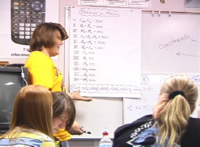
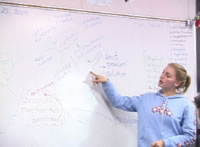
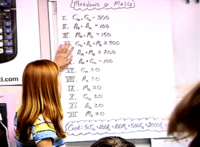
|
MORE ON CLASSROOM DISCUSSIONS
Guiding the conversation
When students raise questions or topics as part of the class discussion, the teacher has to be cognizant of which ideas are important mathematically, which questions will further develop everyone’s thinking—and which ones are insignificant. Many times, if we are trying to get from A to Z, topics that seem like “side streets” can actually be important.
Sometime the students need to take a “side street” in their thinking—something may occur that turns out to be related, or sometimes not. As the teacher, I have to know that taking those “side streets” can be valuable. I have to be prepared to make that judgment call. As a teacher, I have to be open to thinking things through in such a way to consider where the “side street” is going—maybe it seems unrelated today, but perhaps it’s something relevant for tomorrow. If I tune it out now, then I’ve lost that connection for tomorrow.
Classroom etiquette
I establish norms to help the class learn to politely add to the conversation without necessarily raising their hand. This kind of flexibility supports those moments when the students are so excited about an idea that they jump out of their seats to add something to conversation at the board.
Location of the teacher in the classroom
When I was evaluating videos of teaching practice, I found that teachers were typically found at the front of the classroom. I think this positioning sends a message to the students: “I’m in control, I’m the one who knows things, I repeat what you say, I’m the total authority in the classroom.” I’m not saying that I’m not the total authority in the classroom. But if I move around the classroom, if I stand in the back, then I can hear the volume of participation. I can address discipline issues in the back if needed. I can overhear the related (and unrelated) conversations going on, and build up student’s thinking—“that’s a great thought….” I can overhear discussion that might lead to great “side streets” or productive topics of confusion. Someone might say, “I didn’t understand what he just said,” but not feel brave enough to say it. I can ask them to repeat it to the class and ask for responses. |
| VIDEO REFLECTIONS |
|
Clip 7: Setting up a
"low-risk" environment 2
|
(mm:ss) |
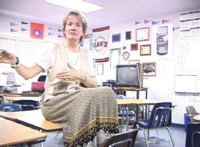 |
| I comment on the teacher's physical position in the room (front v. back of room). |
play
|
Quicktime Player
high • low
get plugin |
Windows Media
high • low
get plugin |
|
|
Site last updated
June 5, 2006
|
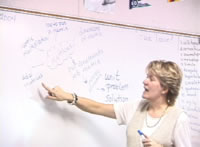 Learning Mathematics
Learning Mathematics 